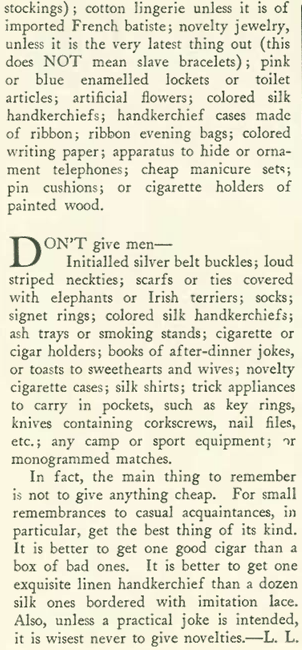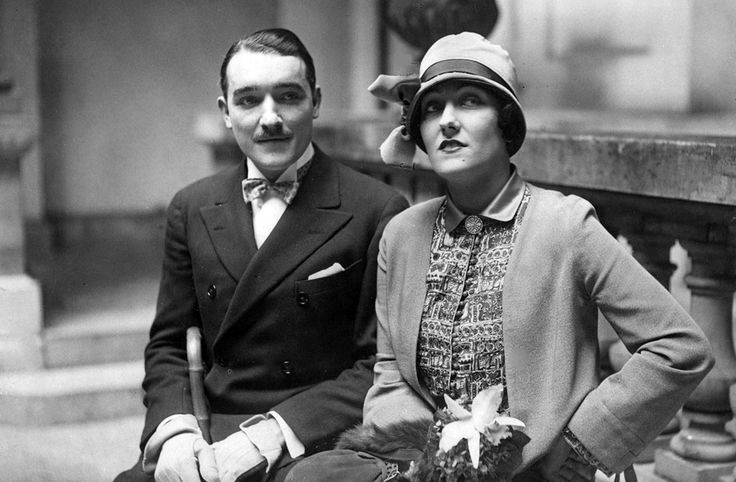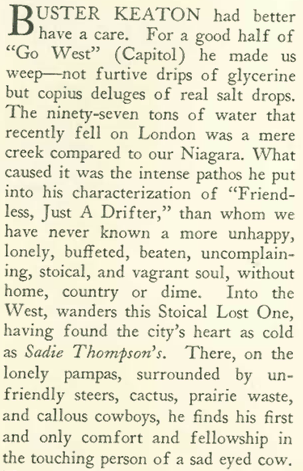
If you are looking for a watershed moment in the history of The New Yorker, this is one of them. The issue of Nov. 28, 1925, featured an article written by 22-year-old Ellin Mackay titled “Why We Go To Cabarets: A Post-Debutante Explains.”
Mackay was the daughter of a Catholic multi-millionaire, Clarence McKay, who was threatening to disinherit his daughter because of her romance with Jewish songwriter Irving Berlin. Mackay’s essay explained why modern women were abandoning the forced social matchmaking of débutante balls in favor of the more egalitarian (and fun-loving) night club scene:
At last, tired of fruitless struggles to remember half familiar faces, tired of vainly try to avoid unwelcome dances, tired of crowds, we go to a cabaret. We go to cabarets because of the very fastidiousness that Our Elders find so admirable a quality. We have privacy in a cabaret…What does it matter if an unsavory Irish politician is carrying on a dull and noisy flirtation with the little blonde at the table behind us? We don’t have to listen; we are with people whose conversation we find amusing. What does it matter if the flapper and her fattish boy friend are wriggling beside us as we dance? We like our partner and the flapper likes hers, and we don’t bother each other.
Mackay’s piece provided a huge boost to The New Yorker’s circulation, which had dipped below a death-rattle low of 3,000 in August 1925 before it rebounded a bit with new and more aggressive advertising and marketing strategies.
The “Debutante” article was featured on the front page of the New York Times, and was also covered on the front pages of other New York newspapers and even in papers across the country. By the end of the year circulation of The New Yorker neared 30,000.
TIME magazine later observed that with the Mackay piece, The New Yorker “suddenly found that it had succeeded in storming the penthouses of High Society. Its success opened the eyes of Editor (Harold) Ross to the importance of the Manhattan socialite, to the fact that Broadway gossip sounds dull on Park Avenue.”
In The New Yorker’s 90th anniversary issue (Feb. 23, 2015), Ian Frazier wrote about the “débutante to the rescue in the Harold Ross era…”
Sometime during the magazine’s early months, Alice Duer Miller gave him (Ross) Ellin Mackay’s “Cabarets” essay. Jane Grant recalled that Ross kept it at the bottom of the pile of manuscripts he brought home, procrastinating because he liked Ellin and expected he would have to reject it, as he often did with others. Grant urged him to run the piece. “It will make wonderful publicity,” she said. Alexander Woollcott, the Times drama critic, with whom the Rosses shared a house…also championed Ellin’s piece. Woollcott knew her through Berlin, whose worshipful biography he had written.
Frazier writes, “In 1,076 words, the “Cabarets” essay had hit precisely the sophisticated young night-club-going, speakeasy-patronizing, up-and-coming, unimpressed-by-their-elders readership Ross was aiming for. The grateful editor gave Ellin Mackay a lifetime subscription to the magazine.” You can read Frazier’s entire article about Mackay and Berlin here.

Mackay, who would publish several novels, would marry Berlin on Jan. 4, 1926. The marriage would last until her death in 1988 at age 85. Berlin would die the following year at age 101.
Here is Mackay’s full article:
* * *
Even as one grand house after another fell to the wrecking ball along “Millionaires Row,” it was hard to believe that the Vanderbilt Mansion between 57th & 58th Streets would also succumb to the commercial interests transforming Fifth Avenue seemingly overnight.
“The Talk of the Town” noted that the doomed mansion, once the largest private home in New York City, was being descended upon by all manner of curiosity seekers:
According to writer Adrian Dannatt, the 130-room, full-scale Renaissance-style château was “originally built to accommodate an entire regal court, a small army, huntsmen and ladies in-waiting, but it was given over instead to a family of eight.”

This grand pile was designed by George B. Post in 1882, with interior design by John LaFarge and Augustus Saint-Gaudens among others. Post, along with Richard Morris Hunt, substantially expanded the house in 1893. Demolished in 1926, Bergdorf Goodman Department Store now occupies the site.

According to Benjamin Waldman, writing for untappedcities.com, a few remnants from the mansion weren’t reduced to dust, including a pair of monumental gates relocated to Central Park and two of six bas-relief sculptures by Karl Bitter that were relocated to the lobby of the Sherry-Netherland Hotel. Apparently the other four disappeared without a trace.

A fireplace designed by Augustus Saint-Gaudens, topped with a John LaFarge mosaic, was donated to the Metropolitan Museum of Art and is displayed in the courtyard of the museum’s American Wing.

“Profiles” looked at the life and work of movie director Cecil B. De Mille. Wrote R. E. Sherwood: De Mille was the “archetype of the motion picture director—a composite photograph of all the Olympian gods who have descended from Mount Hollywood to dominate the earth.”
Harry Este Dounce (“Touchstone”) reviewed John Dos Passos’ new novel, Manhattan Transfer, and noted that Dos Passos’ version of Manhattan was “not the hypothetical typical New Yorker reader’s, but as far as this department knows, it is very much like the real, complete thing—which is to say, like a hell of chaotic futility.”
In “Sports of the Week,” football continued to dominate the column, with a report on Harvard and Yale battling to a 0-0 tie.
With this issue, “Motion Pictures” was moved from the “Critique” section and given its own page under the Johan Bull-illustrated heading “The Current Cinema.” Theodore Shane wrote that he found Laurence Stalling’s The Big Parade “utterly satisfying,” but he was less impressed with the much-hyped Stella Dallas, which he viewed as a contrived weeper designed to draw lovers of such fare to the box office.

Near the back of the magazine the editors printed an exhaustive list of prices on the bootleg liquor market. The prices are quite astonishing, given that $50 in 1925 would be the equivalent of roughly $675 today, based on inflation. Of course that number could vary depending on all sorts of other economic and historic factors, but nevertheless fascinating reading if you are into that sort of thing:
At the conclusion of “The Talk of the Town,” the editors offered this qualifying note regarding their liquor market list:
Next Time: Courtin’ and Sparkin’…






















































































































































